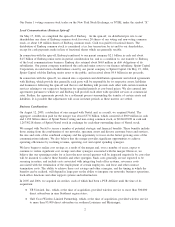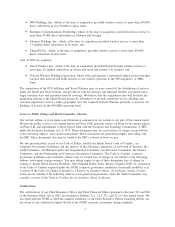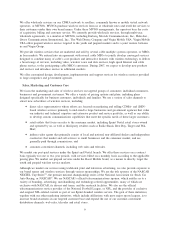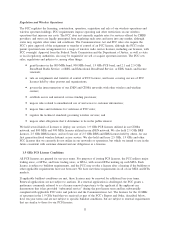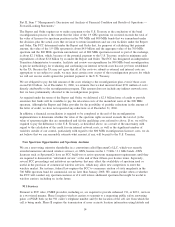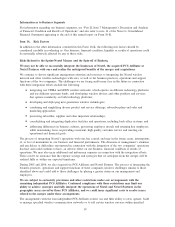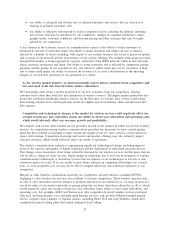Sprint - Nextel 2006 Annual Report Download - page 14
Download and view the complete annual report
Please find page 14 of the 2006 Sprint - Nextel annual report below. You can navigate through the pages in the report by either clicking on the pages listed below, or by using the keyword search tool below to find specific information within the annual report.800 MHz and 900 MHz License Conditions
We hold licenses for channels in the 800 MHz and 900 MHz bands that are used to deploy our iDEN services.
Because spectrum in these bands originally was licensed in small groups of channels, we hold thousands of
these licenses, which together allow us to provide coverage across much of the continental United States. Our
800 MHz and 900 MHz licenses are subject to requirements that we meet population coverage benchmarks
tied to the initial license grant dates. To date, we have met all of these construction requirements applicable to
these licenses, except in the case of licenses that are not material to our business. Our 800 MHz and 900 MHz
licenses have ten-year terms, at the end of which each license is subject to renewal requirements that are
similar to those for our 1.9 GHz licenses.
BRS-EBS License Conditions
We hold and lease FCC BRS and EBS licenses. We currently use a portion of this spectrum to provide fixed
wireless Internet access services to homes and small businesses using “first generation” line-of-sight technol-
ogy. This service operates across the country in 14 markets with approximately 16,500 subscribers. We operate
our network and a third party provides customer care.
In 2004, the FCC ordered that the 2496-2690 MHz band, or the 2.5 GHz band, which is the spectrum for our
EBS and BRS licenses, be reconfigured into upper and lower-band segments for low-power operations, and a
mid-band segment for high-power operations. Transition to the new band plan has begun. We and other parties
are transitioning the 2.5 GHz band to its new configuration market-by-market in a process that may require
several years to complete nationally. As of early January 2007, we had served pre-transition data requests to
licensees in 115 BTAs, filed initiation plans with the FCC for 57 BTAs and filed notices of completion for
transitions in 19 BTAs. When the transition is complete, we believe that the 2.5 GHz band will be more
suitable for our WiMAX next generation broadband wireless network. We intend to provide fourth generation
Wireless Interactive Multimedia Services, or WIMS, and other services, such as fixed point-to-point commu-
nications, using this spectrum.
The FCC affirmed its prohibition of commercial ownership on approximately 62% of the total 2.5 GHz
spectrum band, which is held primarily by educational institutions; however, these institutions are authorized
to lease up to 95% of their licensed spectrum to commercial operators, such as us, subject to certain
restrictions. In addition, the FCC adopted a band plan that requires the relocation of licensed BRS operations
from the 2150-2162 MHz band, or the 2.1 GHz band, into the 2.5 GHz band. The FCC adopted rules that
require new licensees in the 2.1 GHz band to provide incumbent licensees with “comparable facilities,” which
will permit incumbents to continue to offer fixed data services to current and future subscribers if they choose
to do so.
All BRS-EBS licenses are subject to renewal. In January 2007, the FCC Wireless Telecommunications Bureau
reinstated more than 50 expired EBS licenses and additional requests for reinstatement of expired EBS licenses
remain pending at the FCC. We have and will continue to challenge the validity of these requested or adopted
reinstatements, but there can be no assurance that our challenges will be successful. The reinstatement of an
expired license may affect our wireless broadband deployment plans in a market in which the reinstated
license interferes with one or more of our 2.5 GHz holdings or otherwise requires alteration of our deployment
plans.
The FCC conditioned its approval of the Sprint-Nextel merger on two deployment milestones in the 2.5 GHz
spectrum band. Within four years following the August 8, 2005 effective date of the merger order, we must
offer service using the 2.5 GHz band to a population of no less than 15 million people. This deployment must
include areas within a minimum of nine of the nation’s most populous 100 BTAs and at least one BTA less
populous than the nation’s 200th most populous BTA. In these ten BTAs, the deployment must cover at least
one-third of each BTA’s population. In addition, within six years from the effective date of the merger order,
we must offer service using the 2.5 GHz band to at least 15 million more people in areas within a minimum
of nine additional BTAs in the 100 most populous BTAs, and at least one additional BTA less populous than
the nation’s 200th most populous BTA. In these additional ten BTAs, the deployment must also cover at least
one-third of each BTA’s population.
12


